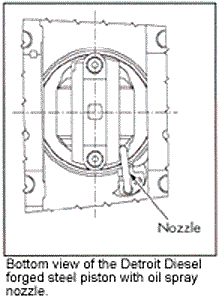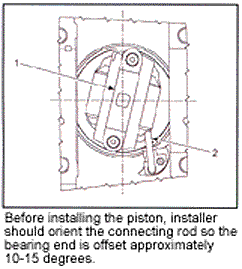Engine Builders: To enhance engine performance and increase durability at higher horsepower output, Detroit Diesel 11.1L and 12.7L premium engines (60-series, 1998-2002 models) use a unique forged steel piston and connecting rod assembly.

The premium engines can be identified with the letters "PK" in the fifth and sixth position (example: 6067PK28) of the model designation.
AERA members have reported revisions to engine block castings which include a drilled oil passage at the base of each cylinder bore. These oil passages intersect the main oil gallery and feed oil to bolt-on spray nozzles (p/n 23521375) that are required when these pistons are used (right). Use of the new steel piston and connecting rod assembly and related components in blocks without cooling nozzles will result in inadequate piston cooling and severe engine damage.
When revised blocks are used in non-premium applications with cast-iron pistons, the oil passages must be closed with bolt-on steel cover plates (p/n 23522437). Nozzles and cover plates are fastened with cap screws (p/n 23506222). Revised engine blocks were introduced March 2, 1998 with engine serial number 6R408505. Failure to close the drilled passages of blocks used for non-premium engine applications will result in drastically reduced main gallery oil pressure and produce severe engine damage.

Failure to orient the connecting rod properly during piston installation may result in the bearing end of the rod striking the nozzle, causing damage to the nozzle or loosening it from the block. A damaged or bent nozzle may not cool the piston properly. A loosened nozzle may cause a lack of main gallery oil pressure. In either case, piston overheating or inadequate lubrication may result in severe engine damage.
Before installing the piston, installer should orient the connecting rod so the bearing end is offset approximately 10-15 degrees and not perpendicular to the crankshaft as is normally the case (above). This will ensure that the rod end does not strike the nozzle when the piston is forced down.
Once the rod end is past the nozzle, turn the rod so the bearing saddle is perpendicular to the crankshaft journal. With the rod seated on the journal, install the connecting rod bearing cap and complete the installation of the piston.
Engine Builders: Drivers may be very concerned about rough running 1998-













